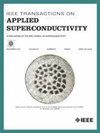设计具有真正 HTS 磁带几何形状的超导螺线管磁铁和线圈的定制有限元法框架
IF 1.8
3区 物理与天体物理
Q3 ENGINEERING, ELECTRICAL & ELECTRONIC
引用次数: 0
摘要
超导螺线管磁体用于磁共振成像和超导磁能存储系统。要优化其设计并预测其性能,必须采用数值方法。在高温超导体(HTS)磁带的实际几何形状上实施有限元法(FEM)具有挑战性,因为磁带的长宽比很大,这给网格划分带来了困难。在这篇文章中,我们针对这一挑战,开发了一个专门为这一应用定制的有限元框架,其重点是速度和易于集成到优化算法中。我们采用了一种新颖的方法,用二维平面上的一个点来表示 HTS 磁带线圈匝的几何形状。每个点对应一个矩阵,既作为代数存储介质,又作为磁带的几何表示。矩阵单元具有虚数维度,可构成线圈匝的几何形状,无需传统的网格划分。该框架的代码经过优化,以提高效率并利用处理器的多个内核。结果与 COMSOL 得出的结果进行了比较,验证了框架的准确性。设计了一个大型磁体来评估计算效率。这一定制有限元框架在优化例程中的成功应用,为设计和预测超导螺线管磁体的性能开辟了新的途径。本文章由计算机程序翻译,如有差异,请以英文原文为准。
A Custom Finite-Element Method Framework for Designing Superconducting Solenoidal Magnets and Coils With True HTS Tape Geometry
Superconducting solenoidal magnets are employed in magnetic resonance imaging and superconducting magnetic energy storage systems. Numerical methods are mandatory to optimize their design and predict their performance. Implementing the finite-element method (FEM) on the actual geometry of a high-temperature superconductor (HTS) tape is challenging due to the large aspect ratio of the tape, which creates meshing difficulties. In this article, we address this challenge by developing a custom FEM framework tailored specifically for this application, with a focus on speed and easy integration into optimization algorithms. A novel approach is adopted, representing the geometry of a coil-turn of HTS tape using a single point on the 2D plane. Each point corresponds to a matrix, serving both as an algebraic storage medium and the geometrical representation of the tape. The matrix cells possess imaginary dimensions that form the geometry of the coil-turn, eliminating the need for traditional meshing. The code of the framework is optimized to increase efficiency and utilize multiple cores of the processor. Results are compared with those obtained from COMSOL, verifying the framework's accuracy. A large magnet is designed to assess the computation efficiency. The successful application of this custom FEM framework in optimization routines opens new pathways for designing and predicting the performance of superconducting solenoidal magnets.
求助全文
通过发布文献求助,成功后即可免费获取论文全文。
去求助
来源期刊

IEEE Transactions on Applied Superconductivity
工程技术-工程:电子与电气
CiteScore
3.50
自引率
33.30%
发文量
650
审稿时长
2.3 months
期刊介绍:
IEEE Transactions on Applied Superconductivity (TAS) contains articles on the applications of superconductivity and other relevant technology. Electronic applications include analog and digital circuits employing thin films and active devices such as Josephson junctions. Large scale applications include magnets for power applications such as motors and generators, for magnetic resonance, for accelerators, and cable applications such as power transmission.
 求助内容:
求助内容: 应助结果提醒方式:
应助结果提醒方式:


